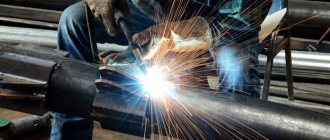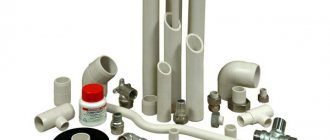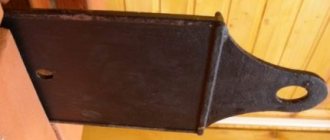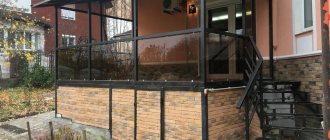Technical progress in the field of water supply network maintenance is constantly moving forward. Means of storing and transporting water, for the manufacture of which ferrous metals (cast iron and steel) were used, are inexorably being replaced. They were replaced by completely new, lightweight, strong and durable polypropylene pipes. Their replacement, that is, the installation of a new water supply network, includes a number of mandatory operations. After carefully familiarizing yourself with the technological features of the production process, you can independently install a polypropylene water supply system.
Polypropylene pipes
Characteristics of polymer pipes
Having examined the variety of different designs made from these materials, it is easy to understand that such pipelines have many advantages, including the following qualities:
Complete independence from the pumped substances
Plastic pipes not only do not change their properties under the influence of liquid passing through them, but also do not affect their chemical composition, which is especially important when constructing drinking water pipelines. Good level of ring stiffness. Pipeline made of polymer materials can withstand pressure equal to 5 MPa
Of course, this is not much compared to systems made of copper and steel, but in most cases the pressure in domestic water supply systems does not exceed half of this figure, so the ring rigidity of polymer pipelines will be quite sufficient even to provide water to an apartment building. Long service life. With proper installation and careful use, a polymer pipe can last 100 years, which is several times longer than that of a non-galvanized steel pipe. The installation process is very simple, most operations can be completed without the help of specialists.
The negative properties of polymer materials common to all types include:
- High level of flammability. During a fire, plastic pipes not only burn, but also release a lot of toxic substances into the environment.
- Poor structural rigidity. Polymer pipes cannot resist either transverse or longitudinal deformations.
- Susceptibility to mechanical damage. The pipe can be damaged by any sharp or heavy object.
Who should change risers in a privatized apartment
It is worth remembering that in addition to the right of ownership, there is also the so-called owner’s burden, which consists of the need to maintain one’s property in good condition and pay for its maintenance.
And here the question arises: who is the owner of those pipes and their branches that are no longer located inside each private apartment, but connect it with utilities that supply water, heat and light to the building itself?
They, as it turns out, relate to common property belonging to all owners. That is, those pipes in the apartment are personal, and the risers are shared.
Legislation
The legislation confirms this. In 2006, the government approved the Rules regarding the maintenance of common property.
They list what exactly applies to property recognized as common:
- Equipment serving more than one apartment.
- Drainage system (i.e. sewerage), etc.
But confirmation of the fact that all pipes, including water, heating, gas and sewer pipes are the property of the residents of the house, does not answer the question of who should change the risers in a privatized apartment? The same document talks about such a concept as repairs (current and major).
The definition of routine repairs given in the Rules for the Technical Operation of Housing Funds includes the following items regarding all pipelines inside a residential building, such as:
- installation;
- replacement;
- restoration of performance.
How is the privatization of emergency housing taking place in 2015? Read here.
Owner's responsibilities
According to the Rules, making decisions about the need for routine and especially major repairs lies with all owners.
Owners of apartments and common property are obliged to:
- ensure the normal technical condition of common building communications;
- make decisions about their repair if the need arises.
But the owners themselves can only repair the equipment that directly serves their apartment. Because it is their private property. And to repair common property, they transfer part of their responsibilities to a management company, which solves all technical problems for them.
This agreement is gratuitous, that is, it implies payment of a certain amount monthly. Its payment is also the responsibility of the apartment owner. In return, he receives technical services for the entire household.
Responsibilities of the Housing Office
Carrying out all repair work required to maintain water supply, sewerage, heating and other risers in good technical condition is the responsibility of the Housing Office. Or another company with which a corresponding agreement was concluded.
The basis for the work will be:
- plan for their implementation;
- an act indicating that any part of the riser needs repair to prevent an emergency;
- a leak or other problem occurs.
You can contact the housing office with an application, which they are obliged to consider and give a reasoned response.
At whose expense
All attempts to force residents to contact private offices or pay additional funds for repairing risers are illegal. Since this work is already carried out at the expense of the homeowners.
Every month you can see the line “maintenance and repair of housing” in notices for payment of utility services. The amount depends on the square footage of the apartment and the number of residents.
According to the norms of MDK 2-04.2004, there are two lists of works that are included in the rent. This includes:
- maintenance of various common property;
- technical and other maintenance of communications;
- emergency work;
- Maintenance.
That is, all replacement, maintenance and repair work is already included in the already hefty rent.
Therefore, the housing office must change the sewer riser in a privatized apartment absolutely free of charge. It's already been paid for.
An exception is the case when repairs are required as a result of unauthorized repairs made by one of the apartment owners or any structural changes to the building's common communications. And if neighbors were injured as a result of such interference, then they will have to be compensated for the damage.
Are you filing an application to the court for forced resettlement and privatization of an apartment? You will find this article useful.
How does inheritance of a privatized apartment take place according to law? See here.
Through a third party or individual
You can easily find dozens of offers for riser replacement services on the Internet.
It’s better to choose an organization; it will be easier to ask for quality.
To do this, it is worth concluding an agreement, otherwise you will have to prove the fact that the work was performed by this organization.
But a private owner can do it no less efficiently and cheaper. Here the choice depends on the caution of the owner and the amount of savings.
The management company also needs to write a statement about disconnecting the riser and agree on a replacement. Often the contractor himself does this for the owner. Payment for work should be made after the water supply has been restored and the tightness of the entire riser has been checked.
Installation of propylene heating
Heating with polypropylene pipes is not installed “plumbing”: it is carried out mainly with fittings; Soldering is only permissible for connecting straight pipe sections to size. Both soldering and fittings for heating pipes also require special ones, more on that below.
Such requirements are explained by reliability considerations: any malfunction will be revealed, at best, during pressure testing of the system before the start of the heating season, or even at its height in severe cold.
Soldering
The technology for soldering polypropylene is described in detail in the corresponding article
To assemble a heating system, it is important to know that soldered butt joints of pipes are unacceptable. The ends of the pipe sections must be soldered into a special coupling: a larger diameter pipe with a stepped internal profile
Accordingly, you need a suitable soldering iron; a regular “iron” will not work.
Fitting
Connection of heating pipes
All corners and tees of propylene heating are assembled only on fittings, and metal ones - “American”, see fig. The shut-off valves are also exclusively metal. A pressed or fused metal frame in metal-plastic connectors with a constant long-term supply of hot water with a temperature above the maximum permissible for hot water supply of 70 degrees will gradually creep out of the plastic frame, which can lead to a sudden breakthrough.
When wiring is hidden, all detachable connections must be accessible for inspection and repair. That is, it is necessary that they can be unscrewed and tightened to standard with a gas wrench of the appropriate size. In practice, this means that the minimum distance from any connection point to the wall of the recess under it was at least 15 cm, to the bottom of the recess - at least 2 cm, and to the top of the recess NO MORE THAN 3 cm. Based on this, the dimensions of the recesses under it should be calculated fittings when laying pipes into the floor.
Bottom line
Reconstructing the heating system in an apartment with your own hands is not a difficult, difficult job and does not require documentation, provided that the radiators are not moved. The main task in its implementation is to carefully consider the choice of pipes, radiators and the possibility of combining them with insulation of the apartment, and especially the floor.
***
2012-2020 Question-Remont.ru
Display all materials with the tag:
Go to section:
Metal-plastic: installation
One of the simplest ways to arrange a home water supply. Composite tubes hold pressure well, bend easily during assembly, and are reliably connected if the installation rules have not been violated. The most popular diameters are 16 and 20 mm. Both open and closed wiring will look good. It is recommended to use a collector circuit.
What will you need?
- Materials: special fittings, pipe fasteners (clamps, ties), flax and sealant.
- Tool:
- pipe cutter and pipe bender for metal-plastic products;
- special press jaws;
- adjustable and Swedish (gas) keys.
How to assemble a pipeline with your own hands?
- Assembly (as in other cases) begins with the creation of a circuit. When planning, it is recommended to provide as few tees and adapters as possible. They reduce water pressure.
- It is important to carefully calculate the lengths of all elements (pipe sections). Cut them and prepare them for installation: bending and cleaning the ends. Using a gauge, trim the ends of the workpieces.
- Using collet or compression fittings, connect the systems into a single whole.
This is what the connection looks like
Installation differences:
- using collets: first a threaded union nut is put on the tube, and then a split ring. All this is inserted into the fitting and tightened tightly;
- using compression fittings: here the role of the ring is played by a wider split sleeve. It is also placed after the nut. When fixing it in the fitting, it is necessary to apply force;
- Push fittings: no tools are needed to create the connection. The tube is inserted into the element and it is fixed. Preventing leaks is achieved thanks to water pressure, which acts on the wedge and reliably presses the edges of the tube;
- Press fittings are used to create permanent connections (without the possibility of disassembly). The pipe must be cut evenly and calibrated. A special sleeve is put on it, and a fitting is inserted inside. Using pliers they press everything together.
Assembling press fittings
When assembling threaded connections, you need to use fum tape or flax.
Video - Metal-plastic assembly process
And how to do it
But leaving aside for now the questions of who should do what and be responsible for what, let’s consider purely technically how it is possible, for example, to replace old pipes with plastic ones. This will allow you to remove worn-out pipes clogged with deposits, installing new ones, and thus help solve the problem of how to increase the heat transfer of a heating pipe - due to the passage of more coolant.
In this case, what your neighbors have will be critical for completing the work. If the neighbors above have already replaced the metal riser pipe with a polypropylene one, then you should install the same one.
It is best if you can agree with them on the possibility of connecting to their junction. In this case, you are dismantling the heating in the apartment, i.e. cut out all the old pipes, cut out an adapter from plastic to metal from a neighbor, determine locally the required length of pipes that need to be laid. Then the metal scrap is pulled out from the ceiling, a propylene pipe is inserted in its place and soldered through a propylene coupling to the neighbor’s pipe.
Connecting a metal and polypropylene pipe using a special coupling
In cases where your neighbors have metal left and they do not allow you to make a joint at their place in order to go through the ceiling, you will have to cut your pipe under the ceiling and cut a thread on its remains. A transition coupling for polypropylene is placed on it, and the corresponding pipe is already connected to it.
If you want the heating replacement in the apartment to be complete, i.e. If you are planning to replace radiators, then you need to start work with them.
There are quite a lot of them, and of very different types, but regardless of this, there are general rules, the implementation of which will allow you to get a good result:
- all radiators in the apartment must be placed equally, on the same level;
- the battery must be positioned strictly vertically;
- its top should be five cm below the window sill and six cm above the floor;
- when attaching a radiator, there should be one mounting bracket per square meter of its surface;
- the front surface of the battery should protrude beyond the edge of the window sill.
Correct installation of a heating radiator
Features of connecting to the wiring
In the place where the vertical pipeline will connect to the wiring in the apartment, install a tee measuring 32/20/32. To facilitate installation of the tee, its end is lubricated with liquid soap. The elements are fixed by soldering.
When planning to install a heated towel rail in the bathroom, two additional tees are installed on the pipeline
An important point: when installing tees, it is preferable not to use a coupling, but a soldered connection.
After installing the shut-off valve, check for leaks. If there is none, fix the assembled structure to the wall.
To do this, using a building level, pre-mark points in the wall for making holes for installing clips. Fastening elements are placed every 100-150 cm.
From the moment the last connection is made, the installed section of the network can be filled with water no earlier than an hour later. To ensure a sufficient level of moisture resistance and sound absorption, the places where pipes pass through the ceilings are concreted throughout the entire thickness. These and other finishing activities are carried out only after testing the structure.
Black steel
Steel rusts. It rusts especially quickly with prolonged contact with water. That is why the service life of steel risers and connections laid down in the regulatory documents, frankly speaking, is not amazingly long.
Standard service life
The main document establishing the standard service life of utilities in a residential building is VSN (departmental building codes) number 58-88, adopted in 1988. They regulate the timing of maintenance, reconstruction and repair of buildings.
Appendix No. 3 to the document provides the following figures:
Destructive factors
What factors limit the service life of VGP pipes without anti-corrosion coating:
| Image | Description |
| Corrosion. Rusting of the pipe is accelerated by a damaged outer layer of paint, frequent shutdowns of the water supply (in this case, the unpainted inner surface of the pipe is in contact with air with high humidity) and poor ventilation in the bathroom (read: consistently high humidity). The first fistulas appear on longitudinal welds (VGP pipes GOST 3262 are electric welded), on threads where the thickness of the pipe walls is minimal, and in ceilings where the surface of the pipes is not ventilated and (in the case of cold water risers) is continuously wetted by the condensate falling on them. | |
| Overgrowing of pipes with deposits (primarily lime salts) and rust. The rate of overgrowing is directly proportional to the hardness of water in the region: where it erodes sediment on the way to the consumer, the clearance in the water supply decreases much faster. The narrowing of the lumen leads to a drop in water pressure on plumbing fixtures connected to the water supply. | |
| Pipeline diameter. The larger the internal cross-section of the pipe, the longer it maintains acceptable throughput. | |
| Wall thickness. According to GOST 3262, ordinary, reinforced and lightweight pipes are produced. It is clear that those reinforced before the first through fistulas appear will last longer. |
Actual service life
In the author’s memory, the minimum trouble-free service life of a steel cold water supply system in a new building was only 10 years. The house was built and delivered shortly before the collapse of the Union, in conditions of austerity on building materials and the actual inoperability of Soviet norms and standards. Lightweight VGP pipes, purchased for reasons of economy, quickly and en masse began to leak at welded joints and threads.
The oldest engineering systems made of black steel have been in service for more than half a century.
In addition to the large thickness of the pipe walls, their longevity is facilitated by:
- Low humidity levels;
- No condensate on cold water pipes;
- Periodic painting of risers and liners;
- Low content of mineral salts in water.
general information
Sooner or later, such pipes begin to fail, after which there is a danger of leakage, pipe splitting, property damage and financial liability.
In order to prevent sad consequences, the riser and sewer branches should be replaced. In such a situation, owners often make do on their own and change the riser in the apartment themselves.
Not everyone knows that sewer and other risers can be replaced at the expense of the management company.
Description of the regulatory framework
There are three types of documents that regulate and control this area:
- MKD 2-04.2004. This is a methodological manual related to the operation and maintenance of residential buildings.
- Standards for technical use of housing stock.
- Rules for maintaining property that is in common ownership.
Replacing risers: who is responsible for it?
RF PP No. 491 provides a description according to which all branches from risers are owned by homeowners. This applies to any type of pipe. This means that the owners are responsible for paying for any expenses and services that arise in this area. In communication systems, other parts represent the common property of the house. In this case, the management company becomes responsible for eliminating any defects and problems.
Who should replace the risers of an apartment building?
You should not think that if apartment owners use common risers, that they are responsible for any types of repairs. Because of this, additional expenses often arise that could have been protected from.
Therefore, the housing office is obliged to respond immediately, without additional fees or requirements.
Replacement standards
Typically, replacement is carried out under two types of circumstances. Either when a complete renovation of the bathroom is carried out, or if the service life of the metal structure has expired.
Pipe replacement also takes place in two modes, planned and emergency. The latter suggests that the integrity of the product was compromised, which is why estrus appeared.
In apartment buildings, the standard warranty period for pipes is less than 25 years. Replacement is necessary, even if the structure has retained its integrity after so much time.
Cast iron pipes are often replaced with polypropylene pipes. This is due to the advantages of new designs:
- Long service life.
- Sliding internal walls, on which almost no plaque forms.
- Resistance to corrosion and other formations.
- Protection against deformation due to thermal effects.
- Environmental Safety.
- Strength.
- Ease.
- Economy.
What is included in the services?
It is assumed that the old structure is removed and a new one is installed instead. But these are not the only actions that make up work.
When the designated date arrives, the water in the risers is shut off, and the remaining liquid is drained. After this, the craftsmen come, with whose employer a contract was previously concluded. It is these workers who are responsible for further replacement actions.
The procedure is performed in the following order.
- Cutting out old pipes using a grinder.
- Next, create markings along which new branches are placed.
- Next, new pipeline structures are installed.
- Run water to check the tightness of joints and other elements.
All items that need replacement are delivered to the owner’s apartment. It often happens that owners are equally responsible for both labor and supplies. According to the law, all expenses must be included in the receipt for the next month.
Replacing the heating riser, whose concern is it?
According to the law, planned replacement of elements of the heating system in apartment buildings must be carried out every 25-30 years at the expense of the management organization, since they are part of the general building communications. When their breakdown occurs before the specified period, then replacing the heating riser in the apartment is the responsibility of the housing and communal services, since all residents pay monthly rent, part of which is aimed at maintaining all utilities of the building.
When residents decide to update outdated risers and heating radiators in their apartment on their own, they will have to do it at their own expense. The same applies to the repair of such a heating system if it breaks down during operation or was initially installed incorrectly.
Replacing heating risers in a municipal building apartment must be done at the expense of the city. In the event that the system breaks down, it is enough to submit an application to the district municipal council, which they, in turn, forward to the management company.
When an apartment is privatized along with all communications included in it, then residents carry out any replacements or repairs of heating risers at their own expense.
Photos of our works
Other jobs
Replacing hot and cold water supply pipes is distinguished by an extremely careful attitude to interior items and a thoughtful approach to the installation of each section.
Type of heating device.
Three types of radiators are suitable for installation in the central heating system of an apartment building from modern heating devices:
-cast iron
-bimetallic
- steel tubular.
The advantage of cast iron radiators is their versatility, due to which their operation does not depend on the direction of coolant supply through the riser, but there are 2 serious drawbacks. Cast iron is a fragile material, so it is not recommended to install them in systems with high pressure, therefore, according to the project, you will never see cast iron radiators in modern high-rise buildings with more than 9 floors. Cast iron also cannot be processed in the same way as steel and aluminum, so the surface of cast iron radiators is always rough and requires additional painting.
Of the bimetallic radiators, it is worth highlighting two models that stand out from the entire variety on the market due to their construction and design: Rifar Monolit and Rifar Supremo.
Rifar Monolit.
Rifar Supreme.
These two models, unlike all other bimetallic radiators, have several important design features:
- radiators have an all-welded manifold, eliminating leakage between sections.
-inlet diameter to the manifold Du-20 (3/4″), which eliminates the need to install a transition fitting mounted on a gasket, which can eventually lose its elasticity and cause leakage.
- wide mounting spaces for brackets, thanks to which the radiator slides without causing any extraneous sounds during thermal expansion on the risers.
The advantage of tubular steel, as opposed to bimetallic, is the absence of a large number of thin plates, which in rare cases can cause acoustic discomfort.
Arbonia steel tubular radiator.
Stop heating the street!
Whether the radiators will be changed during the heating reconstruction process or not, but since they will still have to be removed for some time, it is highly advisable to cut off the outflow of heat to the outside. To do this, you need to cover the wall behind the batteries with heat-insulating mats aluminized on both sides. How such a bedding works in terms of heat can be read in the article on floor insulation; here it is enough to note that in a block Khrushchev house with radiators in niches, double heat shields behind the radiators are equivalent to covering the walls with 20 mm plywood.
In an alternative option for insulating the wall behind the radiator, heat-insulating material (1) and aluminum foil (2) are used separately.
Installing the shielding mat is simple: we cut holes in it for the hooks of the battery suspension, apply thin “sausages” of construction silicone or mounting adhesive using an “envelope” to the side adjacent to the wall, put it on the hooks and press it to the wall.
An indispensable condition: the mat must be organic, made of synthetic or natural fibers. The use of open mineral wool mats in residential premises is unacceptable - it is harmful to health.
Calculation of the required number of sections
For calculations we will use the standard formula - Q=Sx100, where:
- Q – Heat transfer of the radiator, declared by the manufacturer.
- S – Room area.
- 100 is 100 watts, which is enough to heat 1 square. m of premises.
By calculating using the formula, you can determine the power of the radiator required for installation in one room. The calculation is correct if the structure is non-demountable.
For extended radiators, it is necessary to use a different calculation formula - N=Q/Qyc, where:
- N – Number of sections.
- Qyc – Specific thermal power.
- Q – Heat transfer of the radiator, declared by the manufacturer.
The formula is suitable for rooms with a standardized ceiling level of 2.7 meters. Higher ceilings in the apartment require an increase in the number of heating radiator sections.
Choosing the right material
To install a heating system riser, pipes made of stainless steel or plastic are usually used; let's look at their features:
Plastic
Polypropylene pipes and fittings
Today, the use of plastic pipes for arranging heating pipelines has become widespread due to several undoubted advantages:
- Easy to do the installation work yourself. Connections are mainly made using a special pipe soldering iron.
Using a soldering iron to install plastic pipes
- Flexibility. Polypropylene products can bend, which allows you to contour various obstacles without the use of additional fittings.
- A light weight. This greatly simplifies the transportation and lifting of pipes to the upper floors of apartment buildings.
- Relatively low price. Plastic is always cheaper than metal.
- No corrosion processes.
But before choosing polypropylene, you should understand that its strength characteristics strictly comply with the standard operating standards of the heating system and are not designed for such critical conditions as:
- Pressure surges in the heating main from 4-5 to 10-12 atmospheres. Usually this happens only due to the negligence of the mechanics on duty at the boiler room, but, unfortunately, with constant regularity.
- Water hammer. Formed when the heating system suddenly starts up after a summer break.
- Critical temperatures. They can be observed during the annual spring testing of the heating main.
Sample of reinforced polypropylene pipes
Metal
Photos of metal pipes intended for heating systems
In this case, everything is exactly the opposite. Steel products are more expensive, heavier and do not have the flexibility of plastic. But they can withstand any possible temperature of the supplied coolant and high internal pressure. So, if you want to have confidence in the stable operation of your heating system, then it is better to choose the installation of a metal pipeline.
The ideal option from the point of view of practicality and reliability would be to use a galvanized pipe DU-20, which, among other things, is protected from the occurrence of corrosive processes.
Sample of steel water and gas pipe DU-20 with anti-corrosion coating
approximate price
The average cost of replacing 1 riser in central Russia ranges from 2,500 rubles for plastic pipes without passing through the ceiling , to 5,000 rubles with passing through the ceiling.
Replacing with any metal ones will cost 2,000 - 3,000 rubles more. In Moscow the price is 1.5 - 2 times higher. The approximate cost of work in a simplified form is shown in the table:
| Name of works | Cost, rub. |
| Dismantling the riser | 500 — 1000 |
| Riser installation | 1000 — 2500 |
| Passage of 1st floor | 500 — 800 |
| Passage of the 2nd floor | 500 — 800 |
| Cost of materials | 1000 — 1500 |
| Total: | 3500 — 6600 |
| Additional costs are possible for disconnecting, connecting, crimping the riser, sealing the water meter | At UK prices |
When discussing the final price, you should focus on market prices in the region, and not on the estimate provided by the contractor. The estimate can easily justify a cost that is many times higher than current prices.
Who should do maintenance and repairs and when?
According to the above standards, the repair and replacement of heating devices related to common property is assigned to management companies, whose property is the entire heating system in the house, if this heating network does not have boundaries within the apartments (shut-off valves).
The article “Maintenance and repair of common property” can be found in the receipt for payment of services, according to which the owners of apartment buildings pay a monthly fee for the maintenance of this property (how is the heating fee determined?). The management company should seek funds for the repair and replacement of batteries and other communications included in the heating system from this fund.
We figured out who should do the repairs. Now let’s talk about when such equipment should be changed or repaired. In case of emergency - immediately.
The homeowner should not pay for these services to plumbers or other persons.
The issue of replacing radiators is more complicated. Here you should rely on GOSTs and other standards that determine the service life of batteries.
The most reliable installation of polypropylene pipes from 1000₽ in Moscow and Moscow Region in 1 day
Find out the cost of work and materials Distribution of polypropylene pipes to 8 points (toilet, washing machine, sink, bathtub, kitchen sink, manifold) according to the manifold circuit.
Price 1̶6 ̶5̶0̶0̶ ̶₽ 14000 ₽. Warranty up to 3 years. OUR WORK ON INSTALLATION OF POLYPROPYLENE PIPES
13 YEARS IN THE FIELD OF CONSTRUCTION AND REPAIR
Transparent cost of work, no pitfalls. The master will arrive within an hour after the call or at any time convenient for you!











